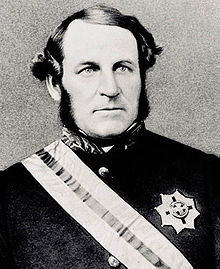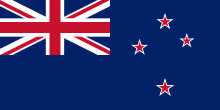George Bowen
Sir George Bowen | |
|---|---|
 | |
| 1st Governor of Queensland | |
| In office 10 December 1859 – 4 January 1868 | |
| Monarch | Victoria |
| Succeeded by | Samuel Blackall |
| 5th Governor of New Zealand | |
| In office 5 February 1868 – 19 March 1873 | |
| Monarch | Victoria |
| Premier | Edward Stafford William Fox George Waterhouse |
| Preceded by | Sir George Grey |
| Succeeded by | Sir James Fergusson |
| 5th Governor of Victoria | |
| In office 30 July 1873 – 22 February 1879 | |
| Monarch | Victoria |
| Preceded by | Sir John Manners-Sutton |
| Succeeded by | George Phipps, 2nd Marquess of Normanby |
| 13th Governor of Mauritius | |
| In office 1879–1883 | |
| Monarch | Victoria |
| 9th Governor of Hong Kong | |
| In office 30 March 1883 – 6 October 1887 | |
| Monarch | Victoria |
| Preceded by | Sir John Pope Hennessy |
| Succeeded by | Sir George William Des Vœux |
| Personal details | |
| Born | 2 November 1821 County Donegal, Ireland,UK |
| Died | 21 February 1899 (aged 77) Brighton, Sussex, England, UK |
| Nationality | |
| Spouse(s) | Contessa Diamantina Roma Florence Bowen |
| Alma mater | Brasenose College, Oxford |
| Profession | colonial administrator |
Sir George Ferguson Bowen, GCMG (2 November 1821 – 21 February 1899) was a British author and colonial administrator whose appointments included postings to the Ionian Islands, Queensland, New Zealand, Victoria, Mauritius and Hong Kong.[1]
Early life
Bowen was born the eldest son of the Rev. Edward Bowen,[2] rector of Taughboyne in County Donegal.[1] Bowen was educated at Charterhouse School and Trinity College, Oxford. Bowen, twice President of the Oxford Union, was awarded a first class Bachelor of Arts degree in classics in 1844,[2] and was elected a fellow of Brasenose College. Bowen was called to the bar by Lincoln's Inn in 1844 and obtained his Master of Arts three years later.[3] In 1846 Bowen had some naval training, serving for sixteen days on HMS Victory.[1] In 1847 Bowen was appointed president of the Ionian University located in Corfu, a post he held until 1851.[1][3]
Service in the Ionian Islands
Bowen became the chief secretary to the government of the Ionian Islands in 1854.[2] While in that post, he married the Contessa Diamantina di Roma on 28 April 1856. Diamantina was the daughter of Conte Giorgio-Candiano Roma and his wife Contessa Orsola, née di Balsamo. The Roma family were local aristocracy; her father being the President of the Ionian Senate, titular head of the Islands, from 1850 to 1856. He was appointee a Companion of the Order of St Michael and St George (CMG) in 1855 and was advanced to Knight Commander (KCMG) in the following year.[3]
Governor of Queensland
In 1859, Bowen was appointed the first Governor of Queensland, a colony that had just been separated from New South Wales. Bowen's influence in Queensland was greater than that of the governors in other Australian colonies in a large part due to Robert Herbert, who accompanied Bowen from England, and later became colonial secretary and then first Premier of Queensland in 1860–66.[1] Bowen was interested in the exploration of Queensland and in the establishment of a volunteer force, but incurred some unpopularity by refusing to sanction the issue of inconvertible paper money during the financial crisis of 1866. But overall, he was quite popular in Queensland, so that the citizens requested an extension of his five-year term as governor, resulting in his staying for further two years.[4]
Governor of New Zealand

In 1867 Bowen was made Governor of New Zealand, where he was successful in reconciling the Māori reaction to the British rule, and saw the end of the New Zealand wars. Bowen also instituted the New Zealand Cross for colonial soldiers, one of the rarest bravery awards in the world and equivalent to the Victoria Cross (he was reprimanded for exceeding his authority).[citation needed]
In 1869, Albert Hastings Markham, first lieutenant of HMS Blanche submitted a design to Bowen for a national ensign for New Zealand. His proposal, incorporating the Southern Cross, was approved and remains in use to this day.[5]
Governor of Victoria
In March 1873 Bowen was transferred to Victoria (Australia) as Governor of Victoria,[1] where he embarked on an endeavour to reduce the expenses of the colony. A political crisis while Bowen took leave in England from January 1875 to January 1876, when acting governor, Sir William Stawell, showed 'too little flexibility in the exercise of his temporary powers'.[1] One of the main issues was the conflict between the Victorian Legislative Council and the Victorian Legislative Assembly; the Council was blocking legislation for its reform and for payment of members.[1] Backed by advice from the Colonial Office, Bowen consented to Premier Graham Berry's plan to break the deadlock by wholesale dismissal of public servants on the so-called 'Black Wednesday'.[1] In May 1878 Bowen said that "my reluctant consent, purely on constitutional grounds, to these dismissals … has damaged my further reputation and my career to a degree that I shall never recover. It will never be forgotten either in England or in the Colony". However several others including Hugh Childers and William Ewart Gladstone approved of Bowen's actions.[1]
Governor of Mauritius
Bowen arrived on Mauritius on 4 April 1879 and served as 13th Governor of the colony until 9 December 1880.[6]
Governor of Hong Kong
On 30 March 1883, Bowen was made Governor of Hong Kong. During his tenure, his administration established the Hong Kong Observatory, which also served as the meteorological institute of the territory. He founded the first college in Hong Kong, and ordered the construction of the Typhoon Shelter in Causeway Bay, and a government hospital. He retired in 1887, due to ill health.[7]
Post-governorship
Bowen returned to England after his time in Hong Kong and was appointed chief of a Royal Commission sent to Malta in December 1887 to help to draft the new constitution for the island. All recommendations made by the commission were adopted. Afterwards, Bowen was sworn of the Privy Council.
Personal life

Bowen was married twice.
His first wife was Contessa Diamantina di Roma, only daughter of Count Candiano di Roma. They had the following children:
- first child, a son who died twelve days old, born in the Ionian Islands
- Adelaide Diamantina (Nina) Bowen, born 17 August 1858 in the Ionian Islands
- Zoe Caroline Bowen, born 28 August 1860 at Adelaide House (the temporary Government House), Brisbane, Queensland
- Agnes Herbert Bowen, born 26 July 1862 at the first Government House in Brisbane
- George William Howard Bowen, born 9 April 1864 at the first Government House, in Brisbane
- Alfreda Ernestina Albertina Bowen, born 10 April 1869 at Old Government House, Auckland, New Zealand
Diamantina died in London in 1893 aged about 60 years old.[8]
George married his second wife, Letitia Florence White, in late 1896 at Chelsea, London.[8] Florence was the daughter of Dr Thomas Luby, a mathematician, and was the widow of Henry White, whom she married in 1878.[8]
George Ferguson Bowen died on 21 February 1899 in Brighton in Sussex, aged 77 years old.[8] He died from bronchitis after a short illness of 2 days. He was buried on 25 February 1899 in Kensal Green cemetery in London.
Legacy
The following were named after George Bowen:
- Bowen, a town in Queensland
- Bowen Hills, a suburb of Brisbane, Queensland
- Bowen Park, a pleasure garden in Bowen Hills
- Bowen Downs Station, a pastoral lease in outback Queensland
- Bowen Bridge and Bowen Bridge Road, a bridge and the road that crosses it, in Brisbane, Queensland
- Bowen Road, Bowen Drive, and Bowen Aqueduct in Hong Kong.
- Bowen Street (now part of the RMIT campus) in Melbourne
His wife Diamantina appears to have been more popular than George in Queensland, as there are many Queensland places named after her.
Honours
- CMG, 1855
- KCMG, 1856
- GCMG, 1860
- Privy Counsellor, 1886
- Honorary DCL Degree, Oxford, 1875
- Honorary LLD Degree, Cambridge, 1886.[9]
Literary works
- Ithaca in 1850, (London, 1851[1] translated into Greek in 1859)
- Mount Athos, Thessaly and Epirus (London, 1852);
- Handbook for Travellers in Greece[1] contributor (London, 1854).
- Thirty Years of Colonial Government (London, 1889, edited by S. Lane-Poole)
See also
- Diamantina Bowen, wife of George Bowen
Notes
- ^ a b c d e f g h i j k l R. B. Joyce, 'Bowen, Sir George Ferguson (1821–1899)', Australian Dictionary of Biography, Vol. 3, Melbourne University Press, 1969, pp 203–207. Retrieved 18 April 2010
- ^ a b c Death of Sir George Bowen, Wanganui Herald, Volume XXXIII, Issue 9676, 23 February 1899, Page 2
- ^ a b c Dod (1860), p. 127
- ^ "The Late Lady Bowen", Brisbane Courier, Monday 27 November 1893
- ^ "Rear-Admiral Sir Albert Hastings Markham, Norfolk Museums and Archeology Service". Retrieved 18 November 2008.
- ^ http://www.worldstatesmen.org/Mauritius.htm
- ^ Chisholm 1911.
- ^ a b c d http://www.freebmd.org
- ^ "Bowen, George Ferguson (BWN886GF)". A Cambridge Alumni Database. University of Cambridge.
- Attribution
- Chisholm, Hugh, ed. (1911). . Encyclopædia Britannica. Vol. 4 (11th ed.). Cambridge University Press.
- Mennell, Philip (1892). . The Dictionary of Australasian Biography. London: Hutchinson & Co – via Wikisource.
- Carlyle, Edward Irving (1901). . In Lee, Sidney (ed.). Dictionary of National Biography (1st supplement). London: Smith, Elder & Co.
References
- Dictionary of Australian Biography – Project Gutenberg
- The Arrival & Reception of His Excellency Sir G.F. Bowen, First Governor of Queensland, Moreton Bay Courier, Tuesday 13 December 1859, page 2
- Departure of Governor Sir G.F. Bowen, The Brisbane Courier, Monday 6 January 1868, page 2
- Reception of Sir G.F. Bowen in New Zealand, The Brisbane Courier, Tuesday 3 March 1868, page 3
- Farewell Ball to the Governor, Waikato Times, Volume III, Issue 135, 20 March 1873, Page 2
- Death of Sir George Bowen, Brisbane Courier, Thursday 23 February 1899
- The Late Sir George Bowen, Brisbane Courier, Monday 27 February 1899
- Death of Sir George Bowen, Wanganui Herald, Volume XXXIII, Issue 9676, 23 February 1899, Page 2
- Dod, Robert Philip (1860). The Peerage, Baronetage and Knightage of Great Britain and Ireland. London: Whitaker and Co.
External links
- Handbook for travellers in Greece at GoogleBooks
- Use dmy dates from September 2011
- 1821 births
- 1899 deaths
- Alumni of Trinity College, Oxford
- Governors-General of New Zealand
- Governors of Hong Kong
- Governors of Queensland
- Governors of Victoria (Australia)
- Irish Anglicans
- Members of the Privy Council of the United Kingdom
- Knights Grand Cross of the Order of St Michael and St George
- People educated at Charterhouse School
- Fellows of Brasenose College, Oxford
- People from County Donegal



